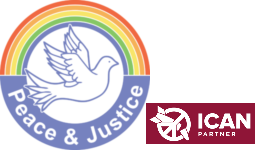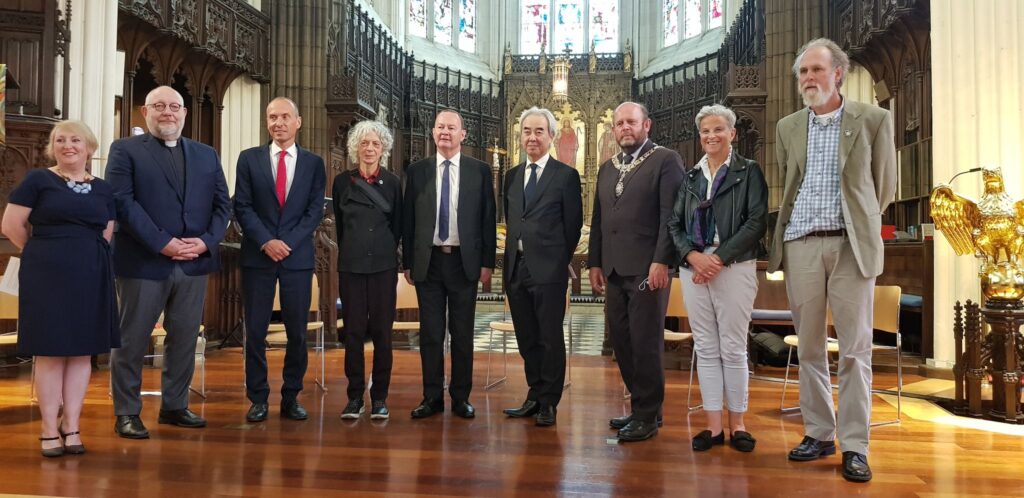
On Friday, 6 August 2021 we marked the anniversary of the Hiroshima bombing with the launch of our Peace Cranes exhibition, which will run at this year’s Just Festival until 28 of August 2021 and remain in place until the 14 November 2021 at St John’s Church on Princes St in Edinburgh.
Speaking at the launch event were the Lord Provost of Edinburgh Frank Ross, Mr Nozomu Takaoka, Consul General of Japan in Edinburgh, and Bill Kidd MSP, Convenor of the Cross Party Group on Nuclear Disarmament at Scottish Parliament.
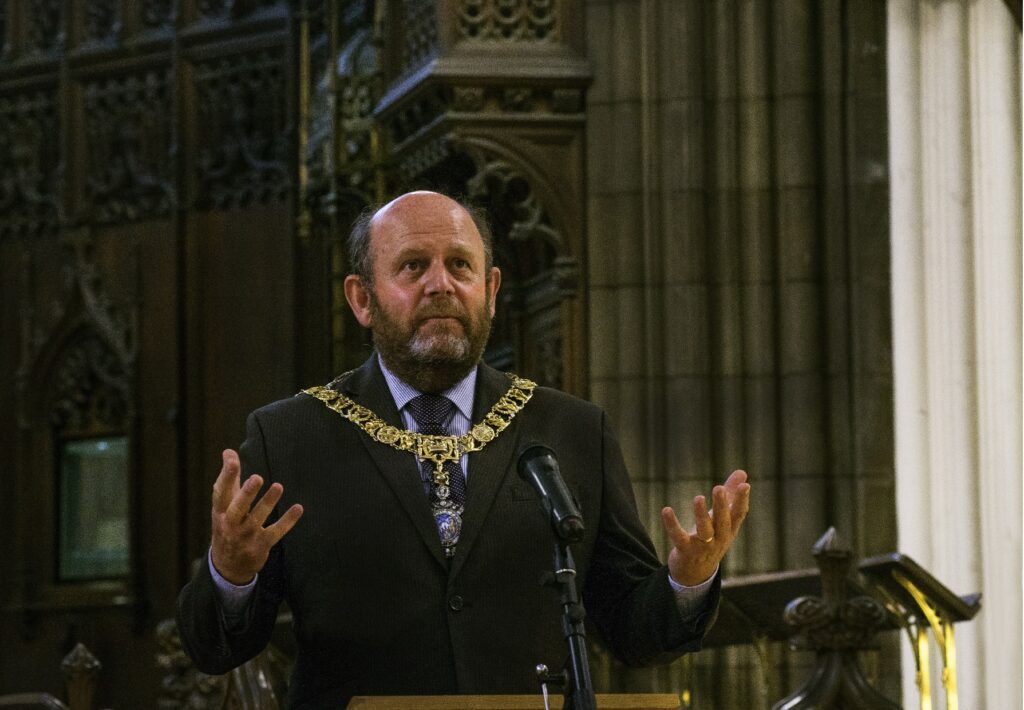
Bill Kidd delivered the congratulations of First Minister Nicola Sturgeon who wrote: “My commitment to a world without nuclear weapons has been unshakeable since I first joined CND as a teenager in the 1980’s. The need for nations and governments to work together to secure a safer, more peaceful world is as great now as it was then, and Peace & Justice Scotland’s Peace Cranes exhibition launch event on Hiroshima Day is an important reminder of the horrors of nuclear warfare.
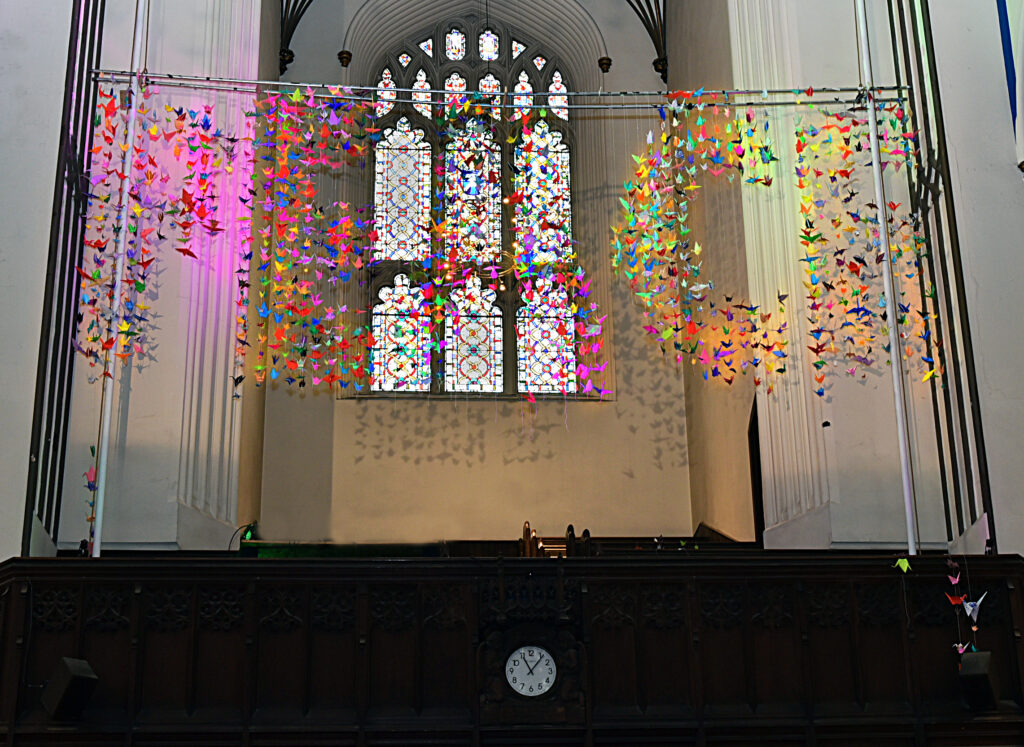
“I was previously privileged to meet some of the survivors of the 1945 bombings, who are known as the Hibakusha, when they visited the Scottish Parliament. My best wishes go to all of those attending the launch of Peace & Justice Scotland’s Peace Cranes exhibition as we look towards a world free from nuclear weapons.”

Our guest of honour was Mr. Nozomu Takaoka, the Consul General of Japan in Edinburgh who “On the 76th anniversary of the atomic bombing of the city of Hiroshima” expressed his “sincere condolences to the souls of the great number of atomic bomb victims” and extended his “heartfelt sympathy to those still suffering even now from the after effects of the atomic bomb.”
Mr Takaoka had met Sadako Sasaki’s former friend, now a medical doctor heading a world class cancer facility in Texas. This doctor had told Mr Takaoka her story when he visited her facility some years ago.
“She and Sadako were good friends and happily went to school together until the age of 10. She said Sadako was an athletic girl, who ran much faster than her. But at the age of 10, she beat Sadako for the first time during a race. And shortly after, Sadako developed leukaemia and spent one year trying to make 1,000 paper cranes in the hope that this would give her extra strength to survive. Sadly Sadako died before she could make 1000. She had been born in Hiroshima shortly before the Bomb was dropped. Today, joining Sadako’s wish for health, life and world peace, paper cranes are made all around the world.”
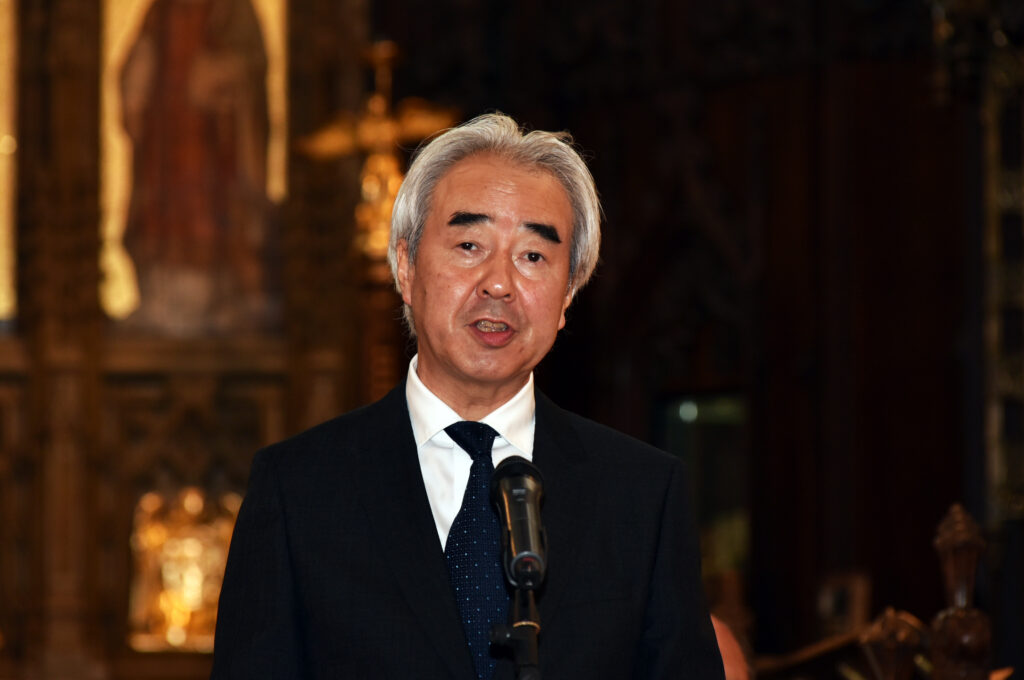
He commended the late Atsuko Betchaku, who began Peace & Justice Scotland’s 140,000 Origami Cranes Project back in 2015, Janis Hart for “inheriting this noble spirit and embodying the powerful message of peace through this monumental installation here at St John’s Church as part of the Just Festival, and everyone else involved in making this project a reality.”
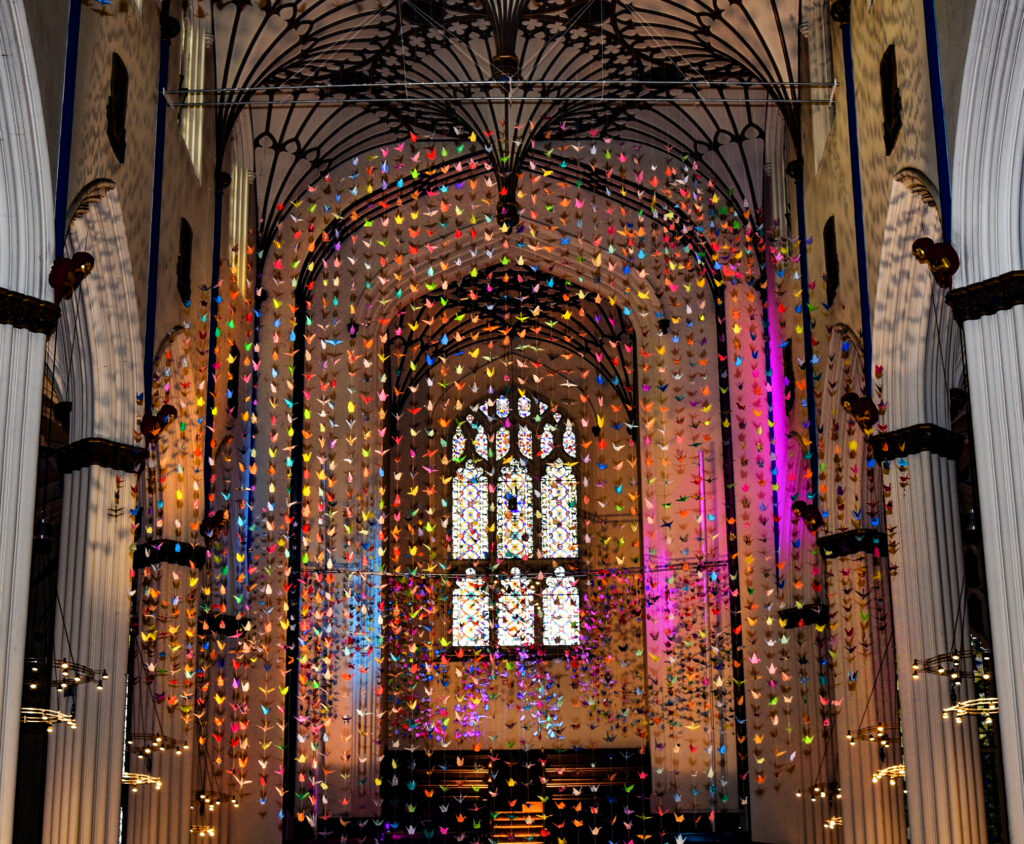
Mr Takaoka also recalled that exactly one year ago, the Lord Provost, Frank Ross, was kind and thoughtful to attend a planting ceremony together with him at the Royal Botanic Garden. They planted Ginkgo Trees “grown from the precious seeds from the miraculous tree which survived the atomic bombing of Hiroshima.”
Therefore, he said, “I am happy to recognise this installation today as a second powerful symbol of hope, resilience and world peace in Edinburgh. This is particularly appropriate and precious since we are now fighting together to overcome the difficulties and challenges put forward by COVID-19.”
“In closing, I pray once again for the repose of the souls of those who fell victim to the atomic bombing, a world free of nuclear weapons and eternal peace.”
Frank Ross the Lord Provost also referred to planting the ginkgo tree in the Botanic Gardens with Mr Takaoka. For him this was more meaningful than that, perhaps because of the involvement of so many individuals in making the exhibition and the powerful work of art that Janis Hart has created. He said he has been to many exhibitions in Edinburgh over the years and of all of them this was the most unique.
Bill Kidd MSP expressed the thoughts of all saying “We keep in our thoughts the survivors – the Hibakusha, who have lived with dignity over these years, many of whom have travelled the world, to this day, reminding us all of the terrible doom which was visited upon their cities and their families 76 years ago. “
“Our Scottish government and Scottish Parliament, have an honourable tradition of standing up and speaking out for a nuclear weapons free world – where peoples of all lands can live and work together with the aim of building a better world for all of our citizens.”
Professor Jolyon Mitchell, Director of the Centre for Theology and Public Issues at University of Edinburgh, giving the keynote address, considered the question ‘How can the visual arts contribute to building peace?’ suggesting that the arts can act as Memorial, Spotlight and Catalyst for change and some of the ways in which Janis Hart’s Peace Cranes installation does just that.
Artworks such as Picasso’s Guernica and the paintings of Paul Nash memorialize the victims of war, but do so in arresting ways. The experience of the First World War was so harrowing that Nash couldn’t paint the faces of the dead so left them blank and portrayed the destruction of the environment and landscape. Janis Hart’s carbonized trees in the chapel, echo the shattered and burned trees in Nash’s paintings.
Not only does each crane represent a victim of Hiroshima, powerfully memorializing them but, just as each crane is unique in the way it is folded and as the light strikes it, can spotlight each victim. Each crane too was made by a unique person, thus bringing every individual involved in the creation of this exhibition together. No two cranes are the same. Each reflects its creator.
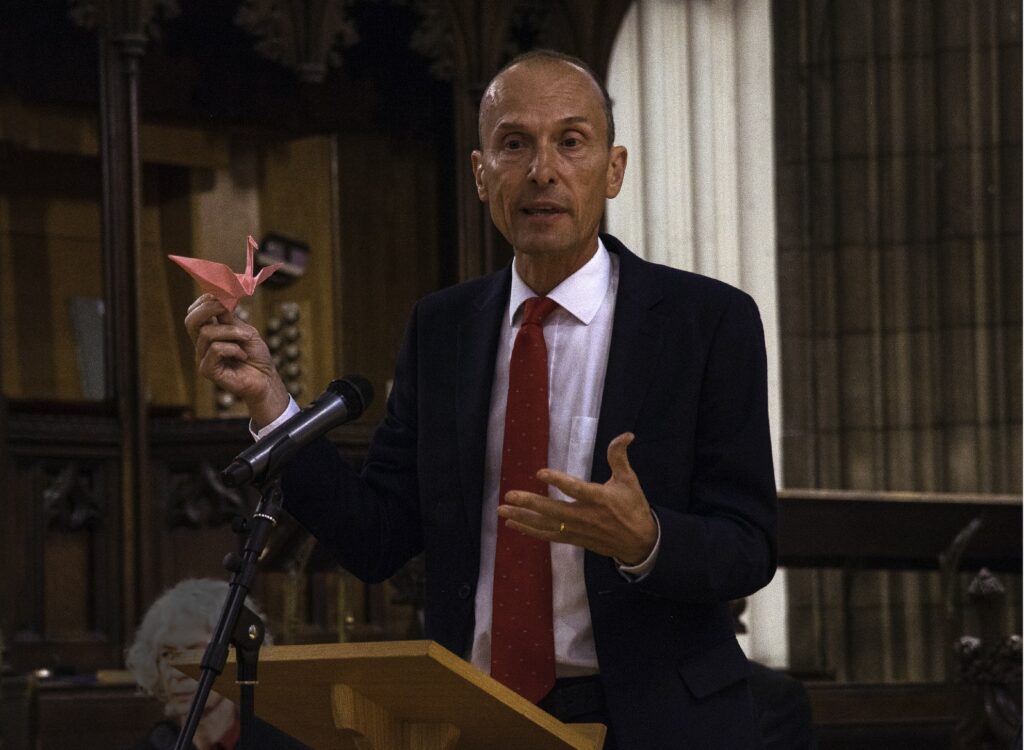
Professor Mitchell considered too how something so insignificant as a piece of paper, so fragile as a single origami crane, could stand against the terrible forces of modern war. Origami cranes have become a powerful symbol of the hopes of people around the world for peace and disarmament and a catalyst for action. And, though each of us may have limited power, the circle of cranes reminds us that together we can end war and destruction and build peace in the world. He hoped that Janis’s work will be such a catalyst.
Finally, birds fly freely together and don’t recognise borders, and cited “Hands across the Divide” (Northern Ireland) which represents the possibility for reconciliation across boundaries and concluded with the words of Bertholt Brecht who said “Art is not a mirror held up to reality but a hammer with which to shape it.”
Reverend Markus Dunzkofer, Rector of St John’s Church, spoke about otherness and diversity. How many of us would hear his accent and knowing he is a gay Rector he asked, would think of him as other? St John’s Church he said embraces diversity, It was one of first congregations to recognise same sex marriage. The Peace Cranes, he said, remind us of the diversity of humanity.
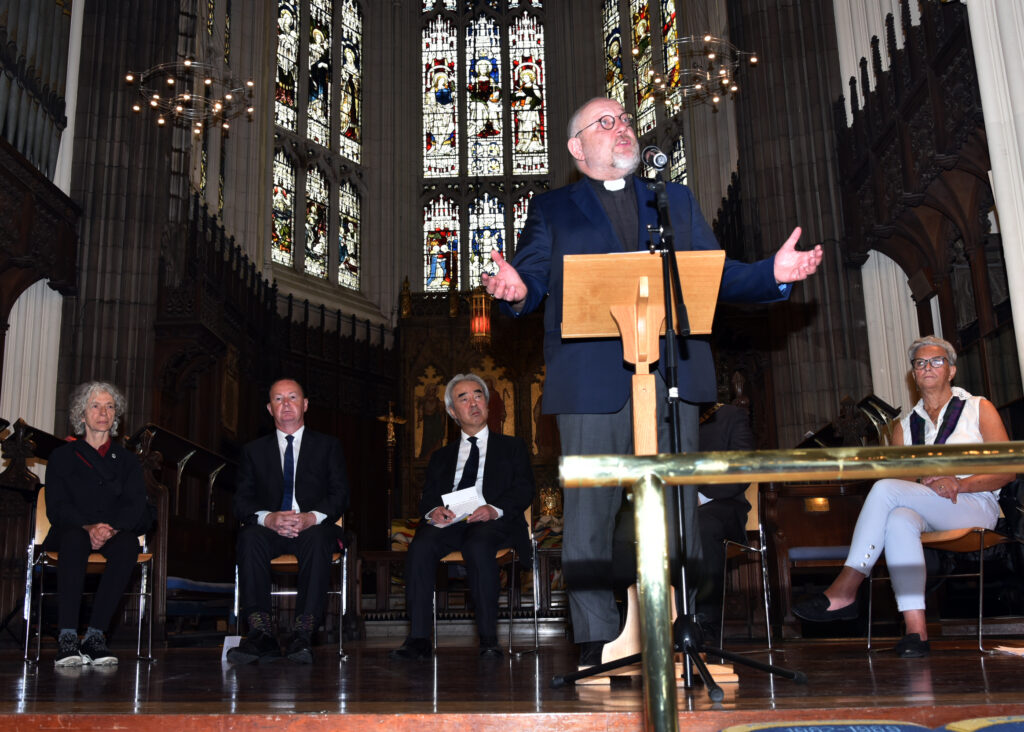
He told of a friend in Chicago, an American whose parents had immigrated from Japan, who while interned during the First World War, had met a school friend of Sadako. This mentor had preached a pacifist message, and sometimes faced hostility from congregations when he preached. One man said to him, “If you don’t like it here why don’t you go back where you came from.” Of course he came from Chicago. It’s an experience that so many pacifists and anti-war activists, especially in the US have had, no matter what their ethnicity.
Lynn Jamieson, Chair of Scottish CND spoke of the widespread opposition to nuclear weapons in Scotland and the support of SCND for the nuclear weapons ban treaty (TPNW) and Lesley Orr thanked all those who contributed to the making of the Peace Cranes exhibition on behalf of Peace & Justice Scotland.
Helen Trew launched the Just Festival, marking 21 years and celebrated the partnership with Peace & Justice as having had many events at Just Festival.
The Peace Cranes exhibition 6 August – 14 November 2021 is a project of Peace & Justice (Scotland) and delivered in partnership with Just Festival and St John’s Church. Peace Cranes is curated by Iliyana Nedkova and Heather Kiernan. Supported by a range of funders, partners and volunteers. For all project updates follow https://linktr.ee/PeaceCranes
